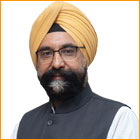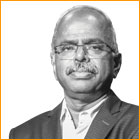 RS SODHI
RS SODHIManaging Director, GCMMF
At Amul, we have never really believed much in consumer insight as far as launching a product is concerned. It is simply because Amul launches only very Indianised products for the aam aadmi. When we are about to launch a new product, we taste it ourselves to see if it feels authentic and real. We are from middle class families, and Anand is a middle class city; so our taste matches that of an average Indian anyway. For example, till date Amul has not launched kheer because I felt none of the samples made tasted like what my mother or grandmother would make, so I rejected them all straightaway.
Around 20 years ago, we did carry out consumer research every two- three years to find out if people liked our products, and what should be done to improve them. That is when we heard from a majority of the consumers that if a soap company can launch an ice-cream product, why not Amul, which is India’s biggest dairy company. Ice-cream manufacturing has been placed under small scale industries by the Government of India from the beginning of commercialization, thereby restricting its growth at a national scale. But Hindustan Unilever went ahead and acquired Kwality which sold icecream back then. We found out that one of our small dairies was producing it, and we continued with it. Then our Chairman Dr Kurien decided to launch it in a big way and changed the rules. The first ice-creams we launched were of vanilla and strawberry flavour.
‘Now, we ensure a whole upsizing of the screens, be it mobile or Television’
 RANJIVJIT SINGH
RANJIVJIT SINGHSenior Vice President & CMO, Samsung India
During a field visit to Mumbai, I realized that typically the flats there are much smaller than those in other cities of India. Yet, I observed that people had huge television sets, bigger than what you would consider ideal for the room. It is part of the build-up for the evening when you sit down and relax with your family and really want to leave all hassles behind by watching that beautiful big screen. That was a very good learning for me, and now we see to it that there is a whole upsizing of the screens, be it mobile or television. More and more consumers are choosing bigger screens because watching TV together is a form of relaxation and an important interaction point for the family. So, television viewing is now where families are bonding together. This is something that came out of observations during field visits.
‘At this Varanasi store, on either side of me was someone drinking an Appy Fizz!’
 NADIA CHAUHAN
NADIA CHAUHANJoint Managing Director and CMO, Parle Agro
I was in Varanasi for a market visit recently and usually during the summer, during a market visit, you tend to see people sitting at outlets and having a drink. At a store in Varanasi, I looked to my left and I saw an old man who appeared deaf, with his family. He sat on a chair and he had in his hand a big bottle of Appy Fizz, which he poured into a glass and quickly drank up. The retailer told me that this man would come to the store every single day to buy an Appy Fizz – he would sit down, drink it and then leave after that. He couldn’t hear, so he could not converse with me nor could he understand why the retailer introduced me to him. On my right, incidentally, was another young man who came in for a bottle of Appy Fizz. Varanasi is one of the markets where we have the Rs 10 glass bottles of the product, so he bought one of those and drank it. It was a fantastic feeling for me in that moment because on either side of me was someone drinking an Appy Fizz! I was delighted! If I were to reflect back on earlier market visits a few years ago, these guys would possibly be drinking a cola or another drink from perhaps another company. But it has been heartening to see how the markets have changed dramatically, and how we have come so far and grown so much over the years. Now we can see our brands everywhere, and we see people choosing to consume them. I felt really proud at how far we have come!
‘We plonked ourselves in salons to see what the customer wanted from champi’
 RAJESH RAMAKRISHNAN
RAJESH RAMAKRISHNANMD, Perfetti Van Melle India
I have two interesting field experiences to cite. The first one was when I was working for Marico around 2000 -2004. We were doing our research before the launch of a cooling hair oil under the Shanti brand. One of the things we did was to go to UP, Bihar and plonk ourselves in salons and barber shops to witness what the customer wants, how he walks in, demands a cooling hair massage, the ‘champi’ that follows, watch the expression he has, etc. Then we would talk to the customers to understand why they need a massage, what do they get out of it, etc. We realized that a lot of them were labourers who work hard during the day, some of them come to the salons with a headache after working in the sun all day and they just need something to cool themselves, and shelling out just Rs 10, they were getting a nice cooling effect through this oil. That gave us an insight into the role the product plays in their lives.
The other interesting example that comes to my mind is when I was handling the brand Kurkure. We were looking to position Kurkure from an anytime-anywhere snack to a snack which is central to tea-time. So the challenge was to get Kurkure from a peripheral place to a central place on the tea tray. We did a lot of consumer immersions back then, like going to people’s homes during tea-time and observing them to see what is it that the housewife or the mother is putting out on a tea tray. In the North, it included anything from bhujiya, mixture, samosas, pakodas and biscuits. Each food item had a different role to play. Some would give a change of flavour to the mouth, some were about filling your stomach because you tend to be a bit hungry by tea-time, etc. It was a totally different range of foods when we did the same exercise in Chennai and the West, where it was about chiwda and bhakarwadis. The whole point was to see where in the scheme of things could Kurkure fit in, and what role can the brand play in that tea tray. That was a very interesting exercise because you sat with consumers, saw what they did over an extended period of time, picked up insights and that’s how the whole tea-time Kurkure campaign was born, saying the role that Kurkure can play during the tea-time is to provide ‘masti’. So the tagline created was ‘Chai time masti bole toh Kurkure’.
‘One conversation with a small vendor helped me enter unchartered territory’
 SANJAY TRIPATHY
SANJAY TRIPATHYCEO, Agilio Labs
This is something that happened when I was a part of PepsiCo and was handling Lays. During those days, Uncle Chipps was the market leader and there wasn’t too much awareness about Lays. In such a scenario, creating a demand was difficult because people would go to shops and ask for the popular brand. However, I figured out there are certain places, like school and college canteens, and cinema halls as well, where people don’t really look at the brands. I figured increasing my brand’s presence in these places could help build an awareness around it. This was in Kolkata, and soon after, I happened to speak to a vendor who used to stay somewhere near New Market. His office was in a small lane and there was no place even to sit. I spoke to this one guy who was the vendor for all institutions. Such places do not usually sell big brands, but I convinced him that I would ensure a good service and replace the products in case of damages. I made sure that he got a fixed margin out of selling my products. Since vendors get more margins for unbranded products, he was a little hesitant initially, but I convinced him and made sure he got a good deal. It was a win-win for both of us and this one meeting and conversation with a local vendor helped me enter this unchartered territory and increase my share in that market in a very short span of time.
‘Healthscreen did for Thyrocare what catchy taglines do for brands…’
 Dr A VELUMANI
Dr A VELUMANIFounder, Chairman and Managing Director, Thyrocare
When I started out, I was a scientist, and knew nothing about business. But, when I got into this business, I discovered that everyone overcharges. Because they overcharged, their volumes were less and there was hardly any profit. That is when I thought – Why not disrupt this market, deliver good quality at a lower cost? So I kept my price low and didn’t make any profit until the first year, when I had volume. I finally broke even in the first year in 1996. That was when we moved towards profitability. Customers would trust us for quality, though we didn’t advertise or use fancy jargon, and we didn’t have any marketing personnel or a big advertising budget. I only launched a magazine called ‘HealthScreen’, which turned everything around for me. Today, in simple terms, the magazine covers everything in the matters of health- disease, health tests, screenings and technology. Twenty years ago, when we launched, I printed 1,00,000 copies, and I circulated them to members of the medical fraternity free of cost. Back then, TV was not ideal for medical businesses so this was the best way to do it. The magazine set the course for a really successful journey for me and for Thyrocare. It also solved one very important problem – if I wanted to speak with a doctor to sell my product, he usually had no time to talk. This was the best way to get the doctor’s attention. Reaching a target of 1,00,000 doctors across India is not easy, but the magazine made it possible. In creating the magazine, I found the easiest way to reach the target audience across the country. Think of any big tagline for a brand – like ‘Washing powder Nirma’, or ‘Thanda matlab Coca-Cola’! My magazine did for Thyrocare what these taglines did for the brands. It made a huge difference in an industry where straightforward advertising would not work.
‘No matter where I went, simple human connections were the most important for me’
 VIVEK NAYER
VIVEK NAYERCMO, Group Corporate Brand, Mahindra Group
When I started my career, I was a management trainee with a Tata company called Voltas. As part of my training, I was posted in Rourkela in Odisha. I used to go from shop to shop - around 35 to 40 visits a day - to sell company goods to them. It was there that I realised the importance of making connections with people at a human level. That was the only way to do business. I knew every Monday, I would be going into market X, every Tuesday I would visit market Y, every Wednesday I would go to market Z and so on. I began to make an effort to remember the retailers’ names and their interests – for example, if they were interested in cricket or Bollywood movies. So, when I would enter the shop, I would exchange greetings and bring up the person’s favourite subject and instantly we would have a connection. The retailer would remember you and chat about a subject he enjoyed and then the process of doing business became much smoother. This became a lesson that governed most of my career as a marketer. Later, I became an area sales manager looking after Bihar and Nepal for the same company and I used to travel and meet distributors, who were big guys. They were dealing with crores of rupees in turnover every year. The same principle worked. When I was on tour to North Bihar, my distributor would offer me tea or ‘paan’. I was someone who probably ate ‘paan’ once in four months, but there I was compelled to eat ‘paan’ everywhere I went because they would be offended if I refused. Their tea would have too much milk and sugar, but it was the drink that helped me connect with them at a human level, leaving business aside for a while. Later with Reckitt Benckiser, I travelled to overseas markets like South Africa and Brazil, but no matter where I went, human connections were the most important in everything I did. You bond over movies, food or music. That kind of connection transcends race, language and community. Everything follows once you establish a simple human connection. This rule has been at the core of everything I have done at every stage in my career.
‘The consumer is important, but all stakeholders involved in the sale process are important too’
 SUDHANSHU NAGPAL
SUDHANSHU NAGPALAssociate Director-Marketing (Biscuits), Mondelez India
The gifting season is a very interesting time for a brand like ours and Diwali is a big festival for North India. Diwali time in Delhi is almost like a carnival. Diwali is big for our business too because the gifting portfolio comes in play and our business more than doubles during the season. During these times, store execution is a battlefield. In 2009, we thought we would get into the game early. We reached out to stores 30 days in advance, put up our products in the stores and felt really good about it, because we thought we had started executing our plan early. About 10 days before Diwali, we went on a market visit and realized many of these stores were erecting pandals outside their premises and putting out a lot of other products there. People were buying things from these temporary pandals and not even entering the shops, where our products were displayed beautifully. So while we had been focusing our energy on putting our designs, products and presence inside the stores, the gifting category was moving out of the store. We got a very interesting insight out of this experience. We know that the customer is at the heart of everything that we do. However, it is equally important to have all the stake-holders involved in the process on your side, and this would include the shoppers, the sales force or even the ‘chotu’ in the shop who is actually responsible for bringing the products from the godown and placing them inside the shops; making him an important person. So during the Diwali season, we started giving away a lot of freebies to people in the store, to make sure they were happy.
‘Feedback on ceiling damage from downlighters made us come up with a new product ’
 SUKANTO AICH
SUKANTO AICHChief Marketing Officer - South Asia, Signify Innovations
Interacting with consumers always gets you great insights. So, as a philosophy in Philips lighting (now Signify Innovations) we are constantly doing that. A simple innovation came out of conversation during these customer interactions. There is a product called ‘downlighters’; they go into the ceiling. Now, a lot of people love these downlighters, but one of the insights we picked up was that when you have to remove these, somebody has to put a screwdriver and take it out. So, the ceiling gets damaged in the process. As a result, people are sceptical about using them because at the end of the day, the ceiling is bigger and costlier than the light. So, on the basis of those insights, we came up with this new product called ‘Ceiling Secure’, making sure that once the outer case goes in, you don’t need to change it. When the light goes out, there is an inner cartridge, you just remove the cartridge and put another cartridge back. We will be running an advertisement based on this consumer insight during the World Cup.
‘The extent to which customers opened up to us strangers was incredible’
 SANJEEV SHUKLA
SANJEEV SHUKLACMO, Muthoot Pappachan Group
While I was on-boarding Muthoot Pappachan Group as the Group Chief Marketing Officer, I took off on a market visit. At Muthoot Pappachan Group, it’s a mustdo to understand our customers’ needs and wants. We met up and chatted with a diverse set of customers in Andhra Pradesh and Telangana. We met a feisty lady, whose husband, in her own words, was good for nothing and she has been running a small clothing shop on her own, travelling hundreds of kilometres to fetch stocks. We met a frail old lady, whose husband was bed-ridden as she bravely ran a small provision store, working 18-20 hours a day. We sipped generously served tea and snacks; many a times tender coconut water, and kept chatting. It was a working day. But they all listened and responded to our questions. Patiently and mindfully. Even without any understanding of the language, we understood the context, used gestures and moved on. We went deeper and deeper into their lives. I still find it incredible as to the extent the customers opened up to us strangers. One man spoke about how his relatives had ditched him and a woman rattled off about her start time at 3 am in the morning and closing time at around 11 pm, making us wonder as to how she was even able to stand through our session, so frail she was! Now, we have enough information and deep insights about these customers. If knowing the customer is the primary and profound aspect of Marketing, then we had discovered and conceptualised a new paradigm in marketing: Conversation Marketing. We need to differentiate between a transactional relationship and a relationship wherein two human beings begin to relate to one another, beyond a certain give and take. In essence, it is not some purpose behind the conversation; rather, conversation with a customer should itself be the purpose.
‘I worked hard to bring in the local flavour of advertising, local campaigning and local faces’
 TARUN JHA
TARUN JHAHead of Marketing, Škoda Auto India
In 2012, I got the opportunity to work with the Škoda Auto headquarters in Prague, Czech Republic as an international marketing consultant. My original beat was Asia Pacific, Africa, and the Middle East, including markets like China, Australia and New Zealand. So, I was the marketing consultant for the non-European markets. That year, we changed our Corporate Identity and Corporate Design (CICD). This included change in the design of the dealership and communication for all our advertising brochures, product literature, etc. I was the first non-European to be hired at headquarters, and the first Asian. One of the things I realized was that in our Middle East markets and also in Israel, the local language script would go from right to left. Our corporate identity designed for European languages went left to right. So, CICDs did not fit into these markets in the Middle East and Israel. I took that information back to headquarters. I worked with them and completely redesigned fresh CICDs for these markets and created a new template for marketing. All the markets in the Middle East loved us for it. I helped them standardize the fonts in Arabic and in Hebrew. Because I came from a non-European background, I could understand how best to handle a market like this and it was a great learning for me too. I began to understand various cultural nuances and their importance. For example, several European brands treat the Christmas season as the festive season. However, the Middle East has a different festive season altogether. So, all the work that we do for Christmas in Europe cannot be replicated there. I used learnings from India when I approached these markets. I worked very hard to bring in the local flavour of advertising, local campaigning and local faces. It was very satisfying. It also made me feel great that the faith my company had placed in me was vindicated.
‘High value purchasers may not always be premium customers, but that is good news!’
 MUDIT SHEKHAWAT
MUDIT SHEKHAWATChief Marketing Officer, Yatra.com
One of the most important segments for any marketer is high value purchasers. Any marketer worth his or her salt would want to identify such high value transactors and ‘recruit’ them for specific programmes designed for such customers. These programmes are fairly commonplace now and usually involve keeping such customers ‘engaged’ by offering them other high value benefits like premium memberships, discounts on premium products and services, etc.
But the biggest revealing insight is that a single or low frequency purchase of a high value product or service doesn’t automatically qualify the customer as ‘premium’. In fact, high value and low frequency categories, e.g., flight tickets, premium fashion labels, etc., are highly penetrated by customers who make very infrequent purchases in the category and would not qualify as ‘premium’ on the basis of other lifestyle markers.
This has been repeatedly revealed in field visits with actual customers. A father of two takes his first ever international flight with his family but does not intend to take one again for at least the next few years since he comes from a fairly modest household. A young professional takes several premium cab rides since they were being paid for by his office on an official trip, a young student saves up and purchases a Rs 15,000 Nike shoe… All of them got marked as ‘premium’ customers, though a customer visit confirmed that other lifestyle markers would not qualify them as premium and the benefits designed to engage them, pre-supposing their lifestyle thanks to their high value purchases.
‘I learnt that you can’t categorize customers solely on the basis of their previous purchase’
 KASHYAP VADAPALLI
KASHYAP VADAPALLICMO, Pepperfry
At Pepperfry, we occasionally go out with our delivery trucks to meet and chat with our customers. Initially, we used to have a categorization where we would have premium products from a price point and design perspective. And then we would have entry level products, much simpler in terms of design and materials and the price point would be entrylevel. Typically, we would look at customers based on that categorization too. So we would target premium customers for premium collections. All our merchandising in terms of emails and offers would be targeted towards a premium line, based on our customer database. Similarly, if somebody had bought an entry level item, we would classify him and send offers only for entry level items. However, once we started visiting customers, we realized it wasn’t so simple, after all. For example, there could be a family living in a small 1BHK in a chawl, but if they were buying a single-seater sofa or an entertainment unit which would be the centre-point of their small living area, they would actually invest money in buying a premium, high quality, high-end product. I once went to visit a family in a 1BHK and there were 3-4 people living in the house. They had just bought a very expensive, high-end computer table or study table which they had put right in the middle of their living room. This surprised me because they did not have too much space. When I asked them the reason, they said that their son was getting into middle school and was interested in computers and they wanted to give him good infrastructure. They also said that they wanted anybody who comes to their home to realize that they don’t spend time watching TV and that learning computers for both their son and daughter is the most important thing. I would never have expected this family to spend around Rs 30,000 on a computer table, but they did. Similarly, a customer living in a bungalow in Malabar Hill had ordered for an entry level show rack. When we went there, we realized it was being used for vendors who come to the bungalow. These were two instances where I was expecting something sitting in my office but the story on the field was completely different. Both these instances made me realize that you can’t categorize customers simply by their addresses or on the basis of their previous purchases. There is no one-size-fits-all kind of strategy here. This insight led to a huge improvement to our mailers and messages we send out to our customers.
‘In 20 years of FMCG marketing, I’d never seen a consumer love a product so much’
 SACHIN KILLAWALA
SACHIN KILLAWALAMarketing Director, Nivea India
In 2013, I was the Global Brand Manager for Nivea Crème, and based out of Germany. The blue tin of Nivea Crème is an icon; it’s been in the market for over a hundred years. At that point, we were trying to figure out what is it exactly that consumers like about the product and we were meeting people across Germany. In this context, I met a young mother who we knew was a big user of Nivea. So I went to her house and got chatting about the product. I also told her to show me the place where she kept it. She had placed the product in the bathroom, next to the wash basin. Our customer profile was matching till now, and the fact that the product was kept in the bathroom meant she used it frequently. However, when I picked up the tin, I found that there was a layer of dust on top of it. Now, a place like Germany has no dust, unless the product has been untouched for months. This was very confusing for me. Why would a customer say she’s a heavy user and essentially not use the product? This was a tension point for me as a marketer. I had to know the reason behind the behaviour. I then informed her that I was doing a survey for the brand around whether consumers really want Nivea Crème, and I told her that we were planning to shut it down. Until then, I hadn’t really told her where I had come from. When I asked her opinion, she said, “Of course we want it.” I replied, “Yes, but it seems like you haven’t really been using the product because it has dust on it.” I asked her when was the last time she’d used it and she couldn’t come up with an answer. She then went on a tirade saying how could we think of shutting the product down; she got agitated and started talking in German-English, and I could capture a bit of it. “You cannot do this because Nivea Crème is my mother,” she said. This blew me away. In the Western world, people part ways with their families at the age of 16 or 17, and start living separately. This woman used to apply the product as a kid and she associated the smell, touch and the haptic of Nivea Crème with her mother. So, while she moved out of her house, she would always carry a tin because the smell and packaging reminded her of her mother. In 20 years of FMCG marketing, I had never seen a consumer love a product so much. This experience completely changed my point of view of the product and overhauled my entire global strategy for Nivea Crème. We actually went from negative growth to positive growth globally. To me, the trigger point was this consumer interaction that we had. The insight out of this experience was the amount of love, trust and care which consumers associate with a particular product. For consumers, it is not just a product, but a much deeper association.























